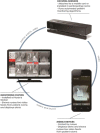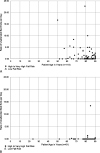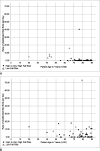Evaluation of Automated Video Monitoring to Decrease the Risk of Unattended Bed Exits in Small Rural Hospitals
- PMID: 33009181
- PMCID: PMC8612902
- DOI: 10.1097/PTS.0000000000000789
Evaluation of Automated Video Monitoring to Decrease the Risk of Unattended Bed Exits in Small Rural Hospitals
Abstract
Objectives: This study aimed to evaluate the effectiveness of using 1 to 4 mobile or fixed automated video monitoring systems (AVMSs) to decrease the risk of unattended bed exits (UBEs) as antecedents to unassisted falls among patients at high risk for falls and fall-related injuries in 15 small rural hospitals.
Methods: We compared UBE rates and fall rates during baseline (5 months in which patient movement was recorded but nurses did not receive alerts) and intervention phases (2 months in which nurses received alerts). We determined lead time (seconds elapsed from the first alert because of patient movement until 3 seconds after an UBE) during baseline and positive predictive value and sensitivity during intervention.
Results: Age and fall risk were negatively associated with the baseline patient rate of UBEs/day. From baseline to intervention: in 9 hospitals primarily using mobile systems, UBEs/day decreased from 0.84 to 0.09 (89%); in 5 hospitals primarily using fixed systems, UBEs/day increased from 0.43 to 3.18 (649%) as patients at low risk for falls were observed safely exiting the bed; and among 13 hospitals with complete data, total falls/1000 admissions decreased from 8.83 to 5.53 (37%), and injurious falls/1000 admissions decreased from 2.52 to 0.55 (78%). The median lead time of the AVMS was 28.5 seconds, positive predictive value was nearly 60%, and sensitivity was 97.4%.
Conclusions: Use of relatively few AVMSs may allow nurses to adaptively manage UBEs as antecedents to unassisted falls and fall-related injuries in small rural hospitals. Additional research is needed in larger hospitals to better understand the effectiveness of AVMSs.
Copyright © 2020 The Author(s). Published by Wolters Kluwer Health, Inc.
Conflict of interest statement
K.J. was an associate professor in the College of Allied Health Professions at the University of Nebraska Medical Center until June 2018, when she retired. She completed this article as an independent contractor. L.S. is employed by Ocuvera, LLC, and has an ownership interest in the company; he did not participate in data analysis. G.H. has no conflicts of interest to declare.
Figures





Similar articles
-
Using a Medical Intranet of Things System to Prevent Bed Falls in an Acute Care Hospital: A Pilot Study.J Med Internet Res. 2017 May 4;19(5):e150. doi: 10.2196/jmir.7131. J Med Internet Res. 2017. PMID: 28473306 Free PMC article.
-
Patient and system factors associated with unassisted and injurious falls in hospitals: an observational study.BMC Geriatr. 2019 Dec 11;19(1):348. doi: 10.1186/s12877-019-1368-8. BMC Geriatr. 2019. PMID: 31829166 Free PMC article.
-
Evaluating the use of multiteam systems to manage the complexity of inpatient falls in rural hospitals.Health Serv Res. 2019 Oct;54(5):994-1006. doi: 10.1111/1475-6773.13186. Epub 2019 Jun 18. Health Serv Res. 2019. PMID: 31215029 Free PMC article.
-
Outcomes of Patient-Engaged Video Surveillance on Falls and Other Adverse Events.Clin Geriatr Med. 2019 May;35(2):253-263. doi: 10.1016/j.cger.2019.01.005. Epub 2019 Mar 1. Clin Geriatr Med. 2019. PMID: 30929886 Review.
-
Shock-absorbing flooring for fall-related injury prevention in older adults and staff in hospitals and care homes: the SAFEST systematic review.Health Technol Assess. 2022 Jan;26(5):1-196. doi: 10.3310/ZOWL2323. Health Technol Assess. 2022. PMID: 35089119
Cited by
-
Nurses' Experience Implementing an Automated Video Monitoring System to Decrease the Risk of Patient Falls during a Global Pandemic.Healthcare (Basel). 2023 Sep 15;11(18):2556. doi: 10.3390/healthcare11182556. Healthcare (Basel). 2023. PMID: 37761753 Free PMC article.
-
A Night-Time Monitoring System (eNightLog) to Prevent Elderly Wandering in Hostels: A Three-Month Field Study.Int J Environ Res Public Health. 2022 Feb 13;19(4):2103. doi: 10.3390/ijerph19042103. Int J Environ Res Public Health. 2022. PMID: 35206290 Free PMC article.
References
-
- Oliver D, Healey F, Haines TP. Preventing falls and fall-related injuries in hospitals. Clin Geriatr Med. 2010;26:645–692. - PubMed
-
- Weiss AJ, Elixhauser A, eds. Overview of Hospital Stays in the United States, 2012. Rockville, MD: Agency for Healthcare Research and Quality; October 2014 HCUP Statistical Brief; No. 180. Available at: http://www.hcup-us.ahrq.gov/reports/statbriefs/sb180-Hospitalizations-Un.... Accessed February 26, 2020. - PubMed
-
- Morello RT Barker AL Watts JJ, et al. . The extra resource burden of in-hospital falls: a cost of falls study. Med J Aust. 2015;203:367. - PubMed
-
- Rubenstein LZ, Josephson KR. The epidemiology of falls and syncope. Clin Geriatr Med. 2002;18:141–158. - PubMed
Publication types
MeSH terms
LinkOut - more resources
Full Text Sources
Medical

